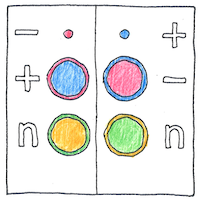Paul Dirac, Carl David Anderson
physics

|
Antimatter
Paul Dirac developed a relativistic wave equation that describes the behavior of electrons and predicted the existence of antimatter. Carl Anderson discovered the positron, the antimatter particle corresponding to the electron, recorded in a cloud chamber from a cosmic ray collision. When particles of antimatter and matter interact the mass of both particles is converted into energy according to Einstein’s equation, its mass multiplied by the square of the speed of light.
Asymmetry
Small amounts of antimatter are created throughout the universe by high-energy cosmic rays, but it is immediately annihilated by an equal amount of ordinary matter on contact. If the creation of matter and antimatter were equally likely why is antimatter so scarce in this universe? Otherwise, why is it not equally likely? One can only say that if it were equally likely then matter and antimatter would have annihilated each other long before now.
Untestable hypotheses
Here I deny the necessity and sufficiency of all our means of seeing— Many things exist that we cannot see or, in seeing, do not know.



The current theory is that matter and antimatter must be created in equal amounts, in pairs; however, in our universe matter vastly overwhelms antimatter. Was there a slight imbalance in the amounts created? Does antimatter decay faster than matter? Did all the antimatter get pushed to distant galaxies or sucked into a parallel universe?
Annihilation of an electron and a positron at rest produces two gamma ray photons; that is, annihilation produces pure energy; however, other types of matter-antimatter collisions are more complex. Annihilation of a proton and an antiproton produces mesons that decay into photons, positrons, electrons, and neutrinos.
See also in The book of science:
Readings in wikipedia: